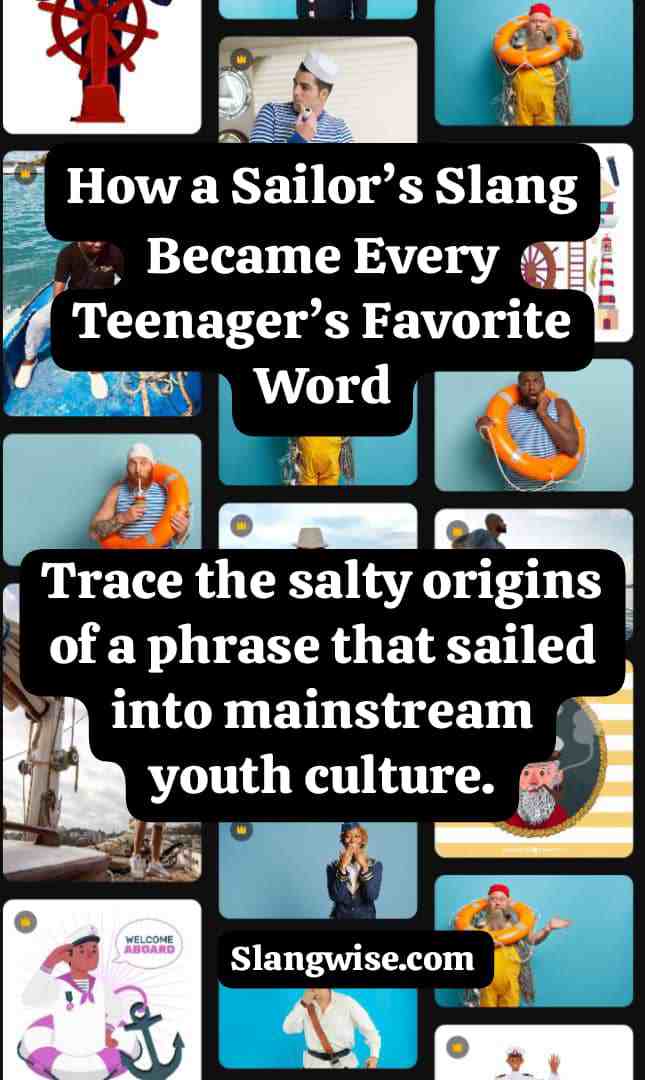In a nutshell
- Salted at sea: Sailors spent months aboard wooden ships, where salt spray and preserved provisions earned them the nickname “salty.”
- First figurative uses: By the 19th century, “salty” described coarse behavior or seasoned experience among mariners.
- Mainstream adoption: Naval tales, dime novels and Hollywood films spread “salty” into everyday language by the mid-20th century.
- Teenage takeover: In the age of memes and TikTok, “salty” has evolved into a go-to term for someone who’s bitter, annoyed or just teasing friends.
SlangWise thought: Even the roughest sailor’s word can anchor itself in today’s teen talk, language is always on the move.
Sailors have long been at the frontline of linguistic creativity. Battling wind and wave, they acquired salty skin, salty language, and eventually, one of the most enduring slang words in English: salty.
Today’s Gen Zs and Gen Alphas use “salty” to tease a friend who’s upset or to mock someone who’s taking a loss too seriously. Tracing this journey reveals how a practical term about salt and seasoning sailed straight into youth culture.
Originally, salty was purely literal. On long voyages, unwashed clothes reeked of brine, and barrels of salt-cured meat were staples below deck.
Early references from the 1700s speak of “salt-soaked” sailors, but by the early 1800s, writers began using “salty” figuratively to describe a person’s harsh or seasoned character, someone toughened by experience at sea.
Read Also: Victorian Slang – 23 Terms That Will Transport You to the 19th Century
This sense appears in seafaring novels of the era: a “salty old tar” was both a veteran mariner and, by implication, a bit rough around the edges.
By the mid-19th century, “salty” had broadened further. It described language and manners considered coarse or bawdy, an extension of the unrefined life aboard ship.
Dickensian characters sometimes spoke of “salty talk,” and newspapers recounting naval incidents used “salty” to evoke the gritty world of sailors. Gradually, the term drifted from ship logs into civilian speech, marking anyone who spoke bluntly or acted gruffly.
The 20th century cemented “salty” in popular culture. World War II veterans returned home with countless sea stories, and Hollywood seized on maritime themes.
Films like Down to the Sea in Ships and later Master and Commander featured characters described as “salty,” foregrounding the word for general audiences. At the same time, magazines and dictionaries recorded this slang.
The Merriam-Webster Dictionary notes its figurative use as early as 1829, “meaning hardened by salt or brine, and by 1916, ‘puckishly rude, vulgar’”.
Yet the most surprising chapter arrived with the internet era. Online gaming, meme culture and social media turned “salty” into a playful taunt. When a player loses a match and vents frustration, opponents chime “Nice try, salty!”
It spread further on platforms like TikTok and Twitter, where short, snappy language reigns. The Online Etymology Dictionary underscores this modern shift: “By 1995, ‘salty’ had taken on the meaning ‘irritated, angry’ in gamer slang” (Etymonline).
Today’s teenagers wield “salty” with finesse. It’s not just an insult but a badge of honor, being salty can mean caring enough to get riled up. The word’s flexibility allows creative spins: “salty tears,” “salty comeback,” even “salty AF.”
Its roots at sea remain a secret handshake for language lovers, but its current meaning unites anyone who’s ever rolled their eyes in playful annoyance.
From creaking decks to glowing screens, salty has proven seaworthy through centuries of change. It began as a skin-deep descriptor for mariners encrusted with brine, evolved into a marker of coarse manners, and finally washed ashore as the go-to jibe in teenage banter.
That journey underscores the living nature of slang: words chart their own courses, weathering every cultural tide, until they dock in the most unexpected harbors.

